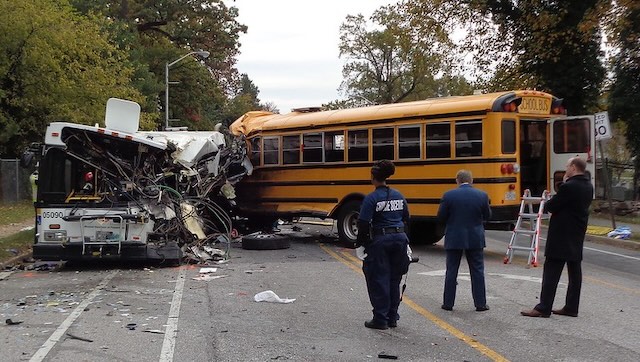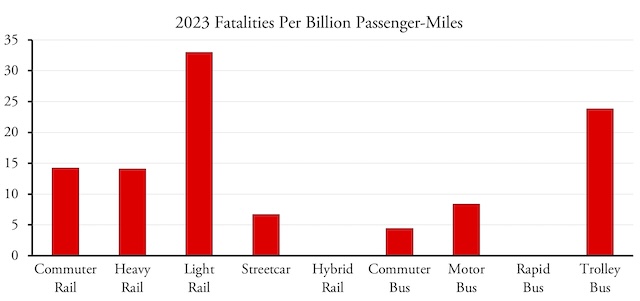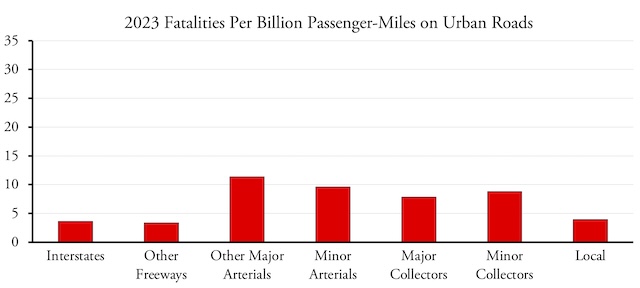“Is public transit really safer than driving?” asks Unscientific American. I call it “unscientific” because the magazine’s methodology was to ask Todd Litman, a Victoria BC transit advocate who has done work for the American Public Transportation Association — not exactly an unbiased observer.
Six people died in this 2016 collision between a school bus and a transit bus in Baltimore. Photo by National Transportation Safety Board.
Litman compared auto fatality rates per billion passenger-miles on all urban roads in 2022 with those on all rail transit in 2013 and all transit buses in 2021. The first problem with this approach is the differences in years: transit carried 40 percent fewer passenger-miles yet killed about 40 percent more people in 2022 than in 2013, so the fatality rate for rail transit was much higher in 2022.
The second problem is Litman’s counting fatalities on all urban roads combined and all forms of rail transit combined. Fatality rates on light rail and commuter rail were much higher than for heavy rail in 2013, but when all forms of rail are combined heavy rail dominates because of New York City. Since all but about seven other cities with rail transit have either light rail or commuter rail instead of heavy rail, this produces a biased picture. In fact, before the pandemic, light rail and commuter rail were both more deadly, per billion passenger-miles, than driving on any kind of urban streets.
Source: Federal Transit Administration Safety and Security Data combined with Federal Transit Administration service data (for passenger-miles). The Federal Railroad Administration keeps track of fatalities by commuter rail, but has not yet posted 2023 fatalities. I used 100, as the number of fatalities in previous years have hovered around 100.
The above chart shows that by 2023 heavy rail fatality rates had caught up with commuter rail. Buses are safer than almost all forms of rail transit. The only thing safer is streetcars because they go too slow to kill someone (and also too slow to be a useful form of transportation). Although not shown here, monorails and automated guideways (people movers) had one fatality, but they move so few passenger-miles that that worked out to 69 per billion passenger-miles.
Sources: 2023 Highway Statistics, tables FI-220 (for fatality rates by billion vehicle-miles) and VM-1 (for average number of passenger-miles per vehicle-mile).
For comparison, the above chart shows the 2023 urban highway fatality rates by road type with the same scale on the vertical axis. Non-freeway arterials are the most dangerous streets, yet in 2023 they were safer than any kind of rail transit other than streetcars. Buses cause about twice the fatalities, per billion passenger-miles, as urban freeways.
Litman might reasonably argue that transit hadn’t yet fully recovered by 2023. But he didn’t hesitate to count 2021 data for buses; it was only for rail transit that he counted 2013 numbers. Since transit ridership declined and transit fatalities rose for most forms of transit between 2013 and 2019, his numbers would have been wrong even without the pandemic.
The Unscientific American article also looked at crime, but compared homicides, assaults, robberies, and other crimes on transit with vehicle thefts and road rage on roads. Even if this wasn’t apples-and-oranges, the writer didn’t attempt to measure crimes per billion passenger-miles so the numbers were meaningless.
All accident fatalities are tragedies and we should do our best to minimize them. Arguments about whether transit is safer than roads are pointless because urban roads carry 100 times as many passenger-miles as transit and that’s not going to change much anytime soon. The real lesson of these data is that, if people want safe cities, they should support bus transit and more freeways while opposing new rail transit.











Typo: “the writer didn’t attempt was made to measure crimes per billion passenger-miles so the numbers were meaningless.”
As the Antiplanner knows, transit advocates, making a case that favors transit, start with the conclusion, then back it up with assumptions that are selected to arrive at the desired conclusion.
Rail transit is statistically safe… because .most rail systems segregate use. Subways are underground, monorail amd Elevated systems abive it. Only lightrail shares road space and usually where there are accidents kits cars trying to beat them at crossings despite warnings to the contrary.
Meanwhile virtually half all automobile related fatalities be they occupants or pedestrians occur on non-freeway arterial aka Stroads.
Websiteuser — thanks; I fixed it.
LazyReader — Except maybe for heavy rail, rail transit isn’t statistically safe because it gets so little use that even a few injuries or fatalities add up to a high number per billion-passenger miles. The monorail/automated guideway is a good example: only 8 fatalities in the last 11 years but it carries so few passenger-miles that it still ends up being 35 fatalities per billion passenger-miles.
Monorail is a good example because
1: It’s virtually impossible to derail
2: they do not impose steel wheel/rail maintenance break cycle
3: because many systems runs in loop circuits they don’t burden system watch with switches and
Multiple trains.
As for rail transit it’s heavily bias.
50-60% ALL Nations rail users occupy the NYC/NJ/Long Island area corridors.
Remainder occupy few large cities , LA, Chicago, Philly, Boston, San Francisco.
Can’t have a lot of fatalities with empty trains. As for Nww York its sunway is dirty and grimy but even century old is still relatively safe. A huge chunk of deaths are suicides on track, homicides or falling.
” Except maybe for heavy rail, rail transit isn’t statistically safe because it gets so little use that even a few injuries or fatalities add up to a high number per billion-passenger miles.”
The AP could rank transportation modes by fatalities per trip rather than mile but then cars would end up being being the most deadliest, so that’s gonna be a big NO from him.
Jane,
Actually, commuter rail would almost certainly be the deadliest by trip as CR trips tend to be several times longer than average urban auto trips. But there is a good reason to use passenger-miles rather than trips as PM is a better expression of the economic benefits gained from a mode of travel. After all, a transportation system that can give you access to a million potential jobs is going to be more valuable than one that can give you access to only a few tens of thousands of potential jobs and other economic opportunities.